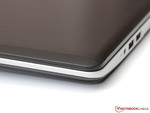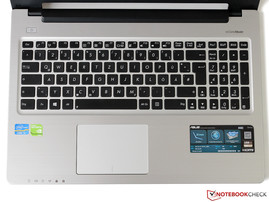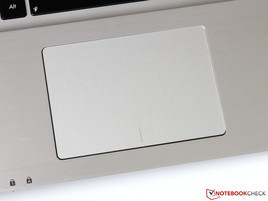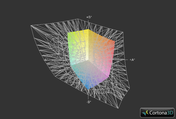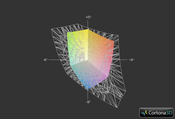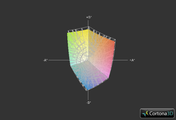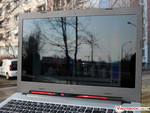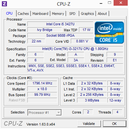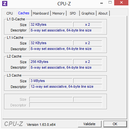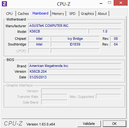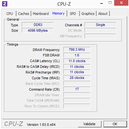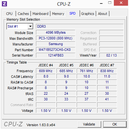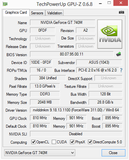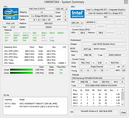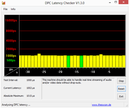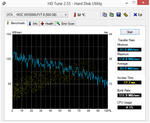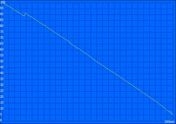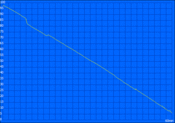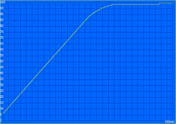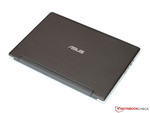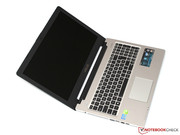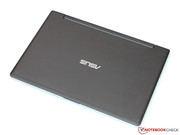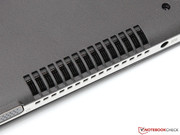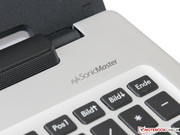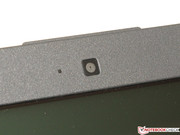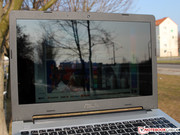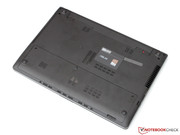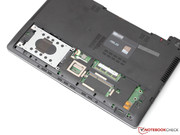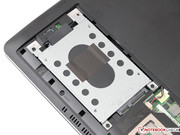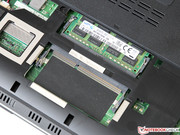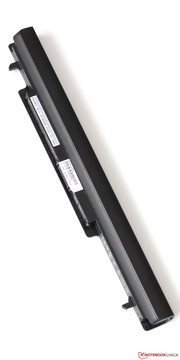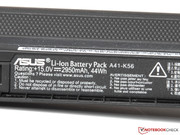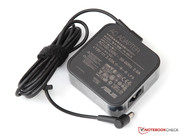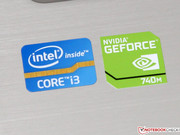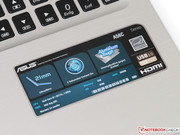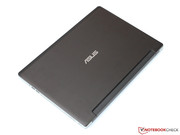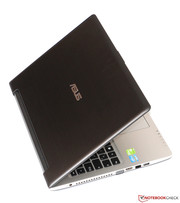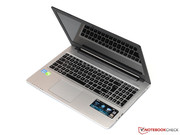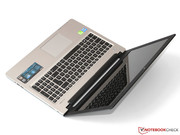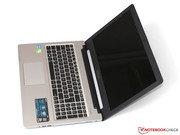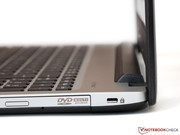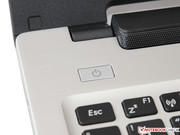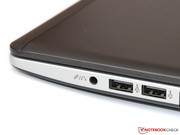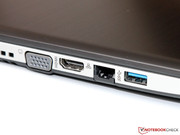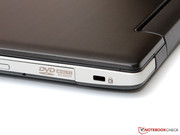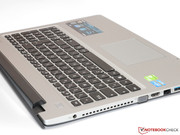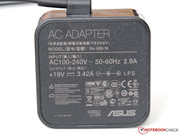Review Asus A56CB-XX053H Notebook

For the original German review, see here.
Slim, light, portable is the trend that can be currently observed across the entire laptop market. What began with the first ultrabooks one or two years ago has now infested office and multimedia laptops.
Asus' new A56CB falls right into this category. Equipped with energy-efficient ULV CPUs from Intel's Ivy Bridge series, the slim 15-incher is to excel with high portability and low emissions. At the same time, the laptop is also to let gaming hearts beat faster. As a special treat, Asus installs the brand new Nvidia GeForce GT 740M that we want to examine in a first performance test in this review. Although our approximately 580 Euros (~$745) entry-level model only sports a Core i3-3217U and has a small storage capacity of 4 GB RAM (500 GB HDD), it promises to be an exciting overall bundle. Alternately, various other configurations are available (excerpt):
- A56CB-XX053H: Core i3-3217U, 4 GB RAM, 500 GB HDD, GeForce GT 740M (from 580 Euros, ~$745)
- A56CB-XX055H: Core i5-3317U, 4 GB RAM, 500 GB HDD, GeForce GT 740M (from 600 Euros, ~$770)
- A56CB-XX057H: Core i7-3517U, 8 GB RAM, 500 GB HDD, GeForce GT 740M (from 750 Euros, ~$962)
- A56CB-XX058H: Core i7-3517U, 8 GB RAM, 1000 GB HDD, GeForce GT 740M (from 800 Euros, ~$1026)
We used Acer's Aspire V5-571G and HP's Pavilion Sleekbook 15 as contenders for Asus' A56CB in the following review. Both aim at the same corner on the market and, depending on the configuration, are sold for roughly the same price of 500 to 600 Euros (~$641 to $770).
Case
A pleasant surprise to begin with: The A56CB makes an impressive high-quality impression for a laptop of this price range. Unlike many other contenders where the label "plastic bomber" would seem appropriate, our device relies on a high-end aluminum chassis. The elegant light metal is used on both the base unit's top and the display's lid. The other parts of the casing are made of a subtly textured, matte-black plastic.
Although the Asus laptop is not officially sold as an ultrabook - the manufacturer only speaks of "ultra-thin" unlike its S56CM - its dimensions and weight easily correspond to the standards of this device category. A thickness of just 21 millimeters and a weight of 2.3 kilograms are remarkable for a high performance 15-inch device, especially seeing that its stiffness has not suffered under this crash diet.
The casing easily defies selective pressure and barely exhibits visible deformations even at typical problem zones such as over the DVD drive. The screen is also stiffer than the class average despite its slim build. It is held by two tight, yet slightly wobbly hinges and requires both hands for opening the laptop.
Apart from a few insignificant details, the build quality is overall compelling. We did not find any sharp material transitions, annoying gaps or other flaws in our test model. Compared with the Aspire V5-571G and Sleekbook 15, Asus' A56CB keeps the upper hand and just scrapes a very good.
Connectivity
USB 3.0 has become standard even in affordable laptops and the A56CB features one such port. The other two of the three USB ports are still regrettably the older 2.0 version and consequently limited to a maximum transfer rate of a good 35 MB/s.
External monitors can be connected via HDMI or VGA as usual. However, the lack of a DisplayPort makes resolutions over 1920x1200 pixels only inconveniently possible, which will particularly affect owners of 27- or 30-inch displays. We will soon examine this issue found across the market more closely in a separate article.
There are only minor complaints about the interface positioning. For example, we would have appreciated the Gbit LAN port at the rear. However, the casing's build and the battery prevent this. The user can easily access all essential ports, such as the headphone jack or SD card reader.
Communication
In terms of wireless communication, the A56CB only provides the common minimum standards. The AR9485 PCIe adapter from Qualcomm/Atheros at least supports the most important Wi-Fi 802.11 b/g/n versions. However, it is limited to the 2.4 GHz frequency band (no 5 GHz networks). The maximum gross data speed via single-stream transmission is 150 Mbit/s (net much less) and could slow down very fast internet connections. Nevertheless, the range and speed will usually be sufficient for home use. Windows certified excellent wireless signal strength at a distance of approximately 5 meters, which means that the aluminum casing does not significantly restrict the Wi-Fi transmission. Unfortunately, Bluetooth is generally not available.
Users who value an appealing picture quality should avoid using the 720p webcam. Low details and high noise ruin the fun of video chats. At least the integrated microphone makes good recordings and could thus replace an additional headset.
Accessories
The laptop alongside the battery, a compact 65 watt power supply and a few mandatory leaflets – there aren't really many accessories. However, it is better that the manufacturer cuts back on accessories than on the laptop's equipment and quality.
Asus also only installs the essentials in terms of software. These include a virus scanner though only a trial version of McAfee Internet Security and the very handy "Asus Tutor" tool that explains the main modifications of the new operating system in simple steps to Windows 8 newcomers.
Maintenance
The user can open the maintenance cover after removing two screws on the bottom and then access the laptop's key components. The hard drive can be exchanged or the working memory can be upgraded in a few steps. Both DIMM slots support a maximum of 8 GB of DDR3 RAM each. We missed an mSATA slot for an additional SSD as well as the option of accessing other components, such as the Wi-Fi module. The laptop would also have to be completely disassembled to clean the fan and heat sink. However, that may include risking loss of warranty.
Warranty
Asus includes a 24 month warranty including pick-up & return for customers in some countries. As usual, this period can be upgraded for a surcharge. An additional year costs approximately 75 Euros (~$96) depending on the supplier.
Input Devices
Keyboard
The chiclet-style keyboard merges seamlessly into the solid aluminum top of the laptop's chassis. Owing to the protruding 15-inch casing, the manufacturer could install both a number pad as well as generous keys with an edge length of 15 millimeters, which contributes to typing comfort. The looks and layout strongly resemble that of the unequally expensive Zenbook UX51VZ sister model.
Overall, the keyboard belongs to the better models on the market although details of the typing feel seem to have room for improvement. The fairly soft stroke could convey a bit more accuracy and have a longer key drop. However, the user will get used to that after a while. In return, the keyboard's low noise and the very meticulous build are compelling.
Touchpad
With a size of 10.5 x 7.3 centimeters, the silver-gray touchpad provides enough room to navigate or implement various multi-touch gestures. The velvety-sleek surface scores with good gliding traits when the fingers are completely dry. Regrettably, our test device's pad was a bit lopsided, which only affects the looks but not the function. More points are deducted for the rather late response.
The lower part of the pad's surface also replaces the mouse buttons, i.e. click pad build. Both keys are a bit too stiff for our taste although the crisp, direct pressure point alongside a rich click noise makes a pleasant, high-quality impression. Nevertheless, the user should use an external mouse in practice.
Display
Just like other laptops of this price range, the screen in Asus' A56CB only has a low resolution of 1366x768 pixels. That results in a pixel density of approximately 100 dpi alongside the screen's diagonal of 15.6-inches. That is not exactly razor-sharp but sufficient for most purposes.
The screen's brightness can also only be called "satisfactory". The brightness achieved an average of 196 cd/m² from the total of our nine measuring points. This is still better than that of the Aspire V5-571G and Sleekbook 15. It is annoying that the brightness is dimmed to only 160 cd/m² in the screen's center when used in battery mode.
| |||||||||||||||||||||||||
Brightness Distribution: 82 %
Center on Battery: 160 cd/m²
Contrast: 545:1 (Black: 0.38 cd/m²)
38.67% AdobeRGB 1998 (Argyll 3D)
54.6% sRGB (Argyll 3D)
37.5% Display P3 (Argyll 3D)
The installed TN screen from AUO (B156XW04 V5) is the same model used in Acer's Aspire V5-571G. Our new X-Rite i1Pro 2 gauge recorded a deeper black value of 0.38 cd/m² and a consequently higher contrast ratio of 545:1 (V5-571G: 193:1) but we cannot confirm this improvement subjectively.
Being an affordable consumer laptop, the A56CB will not satisfy the needs of professional photographers or image editors. Despite calibration, the representation proved to have a bluish cast and shows extreme color deviations in magenta hues among others. In terms of color space, the screen also exhibited weaknesses and failed covering both sRGB and AdobeRGB. However, these restrictions will be insignificant for most private users.
The user will be tormented by distracting reflections outdoors due to the screen's glare-type surface. The much too low brightness, particularly in battery mode, even intensifies this problem so that the screen at most only remains readable in the shade. That is too bad seeing that the ultrabook-like size actually supports mobile use. A matte screen and a brightness of at least 250 cd/m² would help here.
The viewing angle stability is a known weak point of TN screens. Colors distort and the contrast ratio deteriorates when the screen is not viewed from an absolute perpendicular angle. Asus' laptop is just as good or bad as the direct contenders in this issue. Particularly the vertical range of movement is very restricted; at least slight deviations from the sides are tolerated.
Performance
In order to build the casing of the A56CB this light and thin, Asus relies on especially energy-efficient ULV processors from Intel's Ivy Bridge generation. In contrast to their dual-core sisters with a TDP of 35 watts, they are specified with a TDP of only 17 watts.
The lower power consumption of these ULV models is primarily due to lower supply voltages and reduced clock rates. With 1.8 GHz, the Core i3-3217U clearly lags behind the i3-3110M (2.4 GHz, 35 W) and, like all Core i3s, does not feature Turbo Boost technology. However, Hyper Threading for simultaneously processing up to 4 threads is supported and improves the performance in well-parallelized applications. For more details, we would refer to our CPU database.
Since Intel's HD Graphics 4000 is only suitable for gaming to a degree, Asus additionally installs a dedicated Nvidia GeForce GT 740 in the A56CB. Optimus automatically selects the ideal graphics processor for every application. The energy-efficient processor graphics is active during idle periods or in video rendering while the fast GeForce chip takes over for more demanding 3D tasks.
Besides 4 GB of working memory (DDR3-1600, one module), the memory configuration also includes a 500 GB hard drive. Asus unfortunately does not offer SSDs ex-factory.
Processor
The lack of Turbo Boost alongside the ULV-typical low default clock of the i3-3217U has an impact on performance. This especially affects the single-thread performance that is roughly on a par with an older Pentium P6200 with a score of 0.74 points in Cinebench R11.5 (64bit).
In return, the Core i3 benefits from SMT in the multi-thread test and still achieves 1.8 points. For comparison: The equally 17 watt Core i5-3317U with a clock of up to 2.4 GHz during full load takes a lead of approximately 30% with 2.4 points.
This difference is not only measurable but also perceivable particularly in CPU-heavy applications. However, the Core i3-3217U principally has sufficient power for most situations. In view of the low extra charge for a stronger CPU, the buyer should risk looking at the other configurations of Asus' A56CB.
Storage Devices
Asus divides the 500 GB hard drive into two partitions. Together they offer a usable capacity of a lush 400 GB. As usual, the rest is reserved for conversion factors, recovery, Windows and preinstalled software.
The 5400 rpm drive comes from Western Digital's Scorpio Blue product line (WD5000LPVT). The average transfer rate of almost 83 MB/s is quite good for a 2.5-inch hard drive with this speed and barely any worse than some 7200 rpm models. The access time of 17.7 ms is also quite fast and speeds up starting applications and booting processes. Users who are planning to change to an SSD should consider the height of only 7 mm.
System Performance
Our experience shows that PCMark 7 benefits from both strong processors and flash memory drives. Consequently, the A56CB cannot reach the performance level of the fastest ultrabooks. However, the achieved 2253 points are absolutely decent in view of the purchase price and surpasses both the Aspire V5-571G (1858 points) and HP's Pavilion Sleekbook 15 with an AMD APU (1505 points).
The user will hardly ever want more power during routine use. Even multitasking is possible without major restrictions once the selected programs are running. An SSD would bring significant advantages here. The more expensive models featuring a Core i5 and Core i7 processor would likely manage such scenarios even better.
| PCMark Vantage Result | 5109 points | |
| PCMark 7 Score | 2253 points | |
Help | ||
Graphics Card
Now for the likely most interesting part of this review. After Nvidia recently introduced the GT 730M as the first scion of the new 700M series, the second model dubbed GeForce GT 740M follows.
According to rumors, different versions of the graphics card might be available. Besides a version with the GK107 chip (which is also used in the GT 640M, 650M and 730M), a scion featuring the yet fairly unknown GK208 is possible. It is likely a 28 nanometer derivate of the Kepler architecture. We cannot yet state any clock rate specifications or other details about it though.
Apparently, the "old" GK107 has been installed in our test device. It features a somewhat higher clock than the GT 730M. The frequency of the 384 Shader Units is 810 - 895 MHz (730M: usually 725 - 895 MHz), while the 2 GB DDR3 memory with a 128 bit interface runs at an unmodified 900 MHz. The performance differences are accordingly slight. The GPU score of 2066 points in 3DMark 11 is only 7 points higher than the former best result of the GT 730M and can be seen as a difference within the range of measurement tolerance.
| 3DMark 11 - 1280x720 Performance GPU (sort by value) | |
| Asus A56CB-XX053H | |
| Acer Aspire V5-571G-53314G50Makk | |
| Acer Aspire V3-571G-53238G1TMaii | |
| Asus N56VZ-S4044V | |
| 3DMark 06 Standard Score | 8418 points | |
| 3DMark Vantage P Result | 6701 points | |
| 3DMark 11 Performance | 2020 points | |
| 3DMark Ice Storm Standard Score | 31366 points | |
| 3DMark Cloud Gate Standard Score | 4409 points | |
| 3DMark Fire Strike Score | 1195 points | |
| 3DMark Fire Strike Extreme Score | 602 points | |
Help | ||
Gaming Performance
In return, the advantage compared with the Aspire V5-571G is greater. Depending on the game, the GeForce GT 740M outperforms the GT 620M in Acer's laptop twice over and thus makes it possible to render almost all up-to-date games in the native screen resolution smoothly. Often, there are even sufficient reserves for activating AA and AF without the frame rate dropping to a critical range.
However, there are a few exceptions. The processor slowed down noticeably especially in low graphics settings in Hitman: Absolution or Crysis 3. Consequently, neither game achieved the crucial 30 fps mark even in minimum details. As mentioned, it seems recommendable to increase the budget a bit and select the model featuring the Core i5-3317U.
| low | med. | high | ultra | |
|---|---|---|---|---|
| Mafia 2 (2010) | 53 | 47 | 42 | 30 |
| Battlefield 3 (2011) | 42 | 34 | 31 | 12 |
| CoD: Modern Warfare 3 (2011) | 89 | 70 | 55 | 40 |
| The Elder Scrolls V: Skyrim (2011) | 49.2 | 41 | 30.6 | 17.5 |
| Anno 2070 (2011) | 111 | 57 | 35 | 18 |
| Mass Effect 3 (2012) | 36 | 39 | 30 | |
| Risen 2: Dark Waters (2012) | 38 | 34 | 26 | 13 |
| Diablo III (2012) | 94.7 | 71.7 | 70.8 | 52.2 |
| Dirt Showdown (2012) | 41.5 | 30 | 28.9 | 19.1 |
| Max Payne 3 (2012) | 28 | |||
| Darksiders II (2012) | 62 | 35 | ||
| Sleeping Dogs (2012) | 56 | 41.6 | 27.4 | 6.8 |
| Counter-Strike: GO (2012) | 88.1 | 76.7 | 70.2 | 54.1 |
| Fifa 13 (2012) | 139 | 124 | 119 | 62 |
| Dishonored (2012) | 54.7 | 54.4 | 53.3 | 41.2 |
| Medal of Honor: Warfighter (2012) | 64 | 44 | 36 | 11 |
| Need for Speed: Most Wanted (2012) | 52.3 | 44.6 | 32.7 | 19 |
| Call of Duty: Black Ops 2 (2012) | 73.8 | 69.3 | 54.4 | 31.2 |
| Hitman: Absolution (2012) | 28.4 | 26.6 | 17.5 | 7.3 |
| Dead Space 3 (2013) | 133.3 | 75.3 | 58.5 | 38.4 |
| Crysis 3 (2013) | 28.9 | 25.1 | 18.4 | 7.7 |
| Tomb Raider (2013) | 70 | 53.6 | 31.8 | 10.8 |
| SimCity (2013) | 41.6 | 21.6 | 18.2 | 11.5 |
Emissions
System Noise
Asus has perfectly tuned the A56CB's fan management to different load situations so that the laptop never produces more noise than necessary. The fan is usually completely inactive during idle and only leaves the hard drive as the sole noise source with 31.4 dB(A). Activities such as browsing or playing videos are also virtually silent.
Games or other 3D applications increase the noise up to 37.1 dB(A). Despite its much faster graphics chip, Asus' laptop is not any louder than the contenders from Acer or HP. We subjectively perceived the fan's homogeneous and low-pitched noise as fairly quiet and not excessively distracting even after a longer time. We only ascertained higher rates of up to 39.8 dB(A) during simultaneous load using Prime95 and FurMark.
Noise level
| Idle |
| 30 / 30.6 / 31 dB(A) |
| HDD |
| 31.4 dB(A) |
| DVD |
| 36.3 / dB(A) |
| Load |
| 37.1 / 39.8 dB(A) |
 | ||
30 dB silent 40 dB(A) audible 50 dB(A) loud |
||
min: | ||
Temperature
The low noise development regrettably has its downside. Together with the aluminum casing's high heat conductivity, the surface temperatures already reached rates of almost 38 °C in idle. Users who occasionally use their laptop on the thighs will likely soon find this unpleasant. The temperatures climbed even higher during full load, but altogether remained within an acceptable range.
The question whether the device throttles during load recurrently arises especially when dealing with ultrabooks and very thin laptops. We can give the all-clear in this case. The A56CB did not throttle even after one hour of our stress test. The processor and graphics card maintained their maximum clock of 1800 and 895 MHz. The low temperatures of below 80 °C let us assume that the cooling system will easily cope with even faster i5 and i7 CPUs.
(+) The maximum temperature on the upper side is 39.2 °C / 103 F, compared to the average of 36.9 °C / 98 F, ranging from 21.1 to 71 °C for the class Multimedia.
(-) The bottom heats up to a maximum of 45.2 °C / 113 F, compared to the average of 39.2 °C / 103 F
(+) In idle usage, the average temperature for the upper side is 31 °C / 88 F, compared to the device average of 31.3 °C / 88 F.
(±) The palmrests and touchpad can get very hot to the touch with a maximum of 39.2 °C / 102.6 F.
(-) The average temperature of the palmrest area of similar devices was 28.7 °C / 83.7 F (-10.5 °C / -18.9 F).
Speakers
"Crystal Clear Sound" and "Deeper & Richer Bass" are only two slogans that Asus uses to praise the laptop's integrated "SonicMaster" sound system. However, only two simple stereo speakers, which at most can serve with average sound quality, cannot fulfill that. The small speakers noticeably falter particularly in the low ranges so that a part of the atmosphere is lost in music and high-effect movies. The playback of trebles and mids is fairly good although some contenders achieve a slightly higher surround sound and volume. Here, an external sound system would help. It can be connected via the digital HDMI or the conventional 3.5 millimeter jack (light noise).
Energy Management
Power Consumption
Despite Optimus support and energy-efficient ULV CPU, the A56CB cannot quite compete with the low idle consumption rates of the Aspire V5-571G. We ascertained 8.6 to 12.3 watts, which is approximately 2 watts more than Acer's laptop and within the range of other 15-inch, multimedia devices.
Our test model also consumed a bit more power with 50.6 to 54.2 watts during load (V5-571G: 42.1-49.5 watts), which was expected considering the much faster graphics solution. These rates will likely increase by about 5 watts when equipped with the stronger Core i5-3317U. Asus has designed the included 65 watt power supply sufficiently.
| Off / Standby | |
| Idle | |
| Load |
|
Key:
min: | |
Battery Runtime
The A56CB's battery is not exceptionally big with a capacity of 44 Wh. However, the contenders from Acer and HP sport even smaller power storages (both 37 Wh).
This advantage is nullified by the somewhat higher power consumption. We only ascertained a runtime of almost 5 hours in Battery Eater's Reader's test using the energy saving mode, minimum brightness, Wi-Fi and GPU off (V5-571G: 5 h 34 min).
The user can browse on the internet for 3 hours and 52 minutes until the battery's reserves are exhausted, as we ascertained in a practical scenario via Wi-Fi and adapted brightness (approx. 150 cd/m²). Playing a DVD is possible for at most 3 hours and 27 minutes. That is a somewhat better result than in the direct comparison with the idle runtime. However, some ultrabooks last quite a bit longer.
Since neither the CPU nor GPU clock rates are throttled in battery mode, the user has the laptop's full power available even remote from the mains. However, the possible runtime is reduced accordingly. We could not achieve more than 60 minutes in Battery Eater's Classic test using high-performance mode, maximum brightness, Wi-Fi and GPU on.
Verdict
The concept of a particularly portable multimedia laptop is not new. Almost every major manufacturer now has a corresponding model in its product line, even if configuration and price differ extremely.
Despite this intense competition, Asus' A56CB manages to stand out from the bland masses in our review. The reasons for this are simple. Other manufacturers might offer a slim build, a high-quality aluminum casing and gaming-suitable hardware, but hardly ever for a comparable price of below 600 Euros (~$770). Unlike in many ultrabooks, the buyer does not have to waive on an optical drive or essential ports like Gbit LAN.
Naturally, Asus had to make cutbacks in a few areas. The simple WXGA screen based on TN technology is an almost inevitable drawback in this price range. We also missed an mSATA slot as well as a bit more processor power. The available Core i5 version for a slightly higher price will likely get along even better with the fast GeForce GT 740M and is probably the most balanced configuration of the laptop. This almost takes the suspense out of our final verdict. The bottom line is that Asus' A56CB has definitely earned a purchase recommendation.




